Web3 Developer Report (Q3 2022)
Author: Alchemy Team
Web3 developers are building faster than ever despite market headwinds
Despite the crypto winter, with both Bitcoin and Ethereum down roughly 70% from their November 2021 highs, web3 developers are more active than ever. In fact, 2022 has been the biggest year yet.
We took a deep dive into the data, with the help of some of our friends at Etherscan, DappRadar, Github, NPM JS, CoinMarketCap, and the Internet Archive, to see if we could paint a clearer picture of what the web3 developer landscape looks like amid wild macro-market volatility.
We started by analyzing the usage of two critically important web3 libraries: Ethers.js and Web3.js. These libraries let developers read blockchain data through providers like Alchemy and send transactions on behalf of their users to facilitate deposits into DeFi protocols, create NFTs, and much more. They’re an essential tool to build web3 products.
In 2018, only 146,000 developers installed either of these libraries on a weekly basis. But that has increased steadily every year and in 2022, that number had increased 10x: a whopping 1,536,548 downloads per week. Compared to Q3 2021, the number of downloads increased by 3x this quarter.
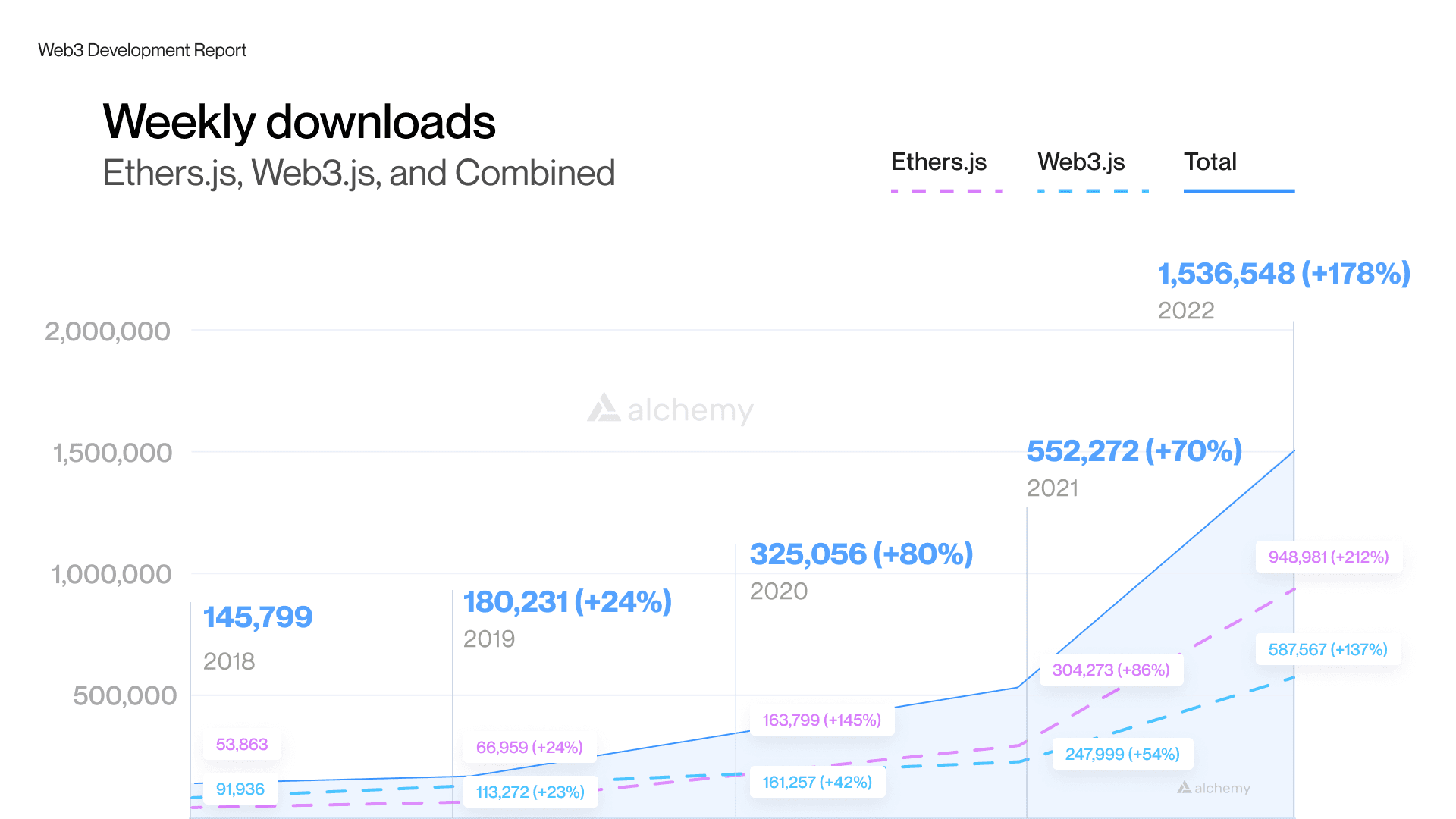
This metric alone points to a large and growing interest in building applications on Ethereum, but we didn’t stop there.
Smart contracts represent the core logic for DeFi protocols and NFT minting contracts, similar to how server logic determines application and database behavior for many internet products today. In other words, an increase in smart contract deployment indicates healthy developer activity and growth.
In September, developers submitted more than 17,376 smart contracts to the popular block explorer, Etherscan, up 160% YoY, showing a surging interest in decentralized protocols.
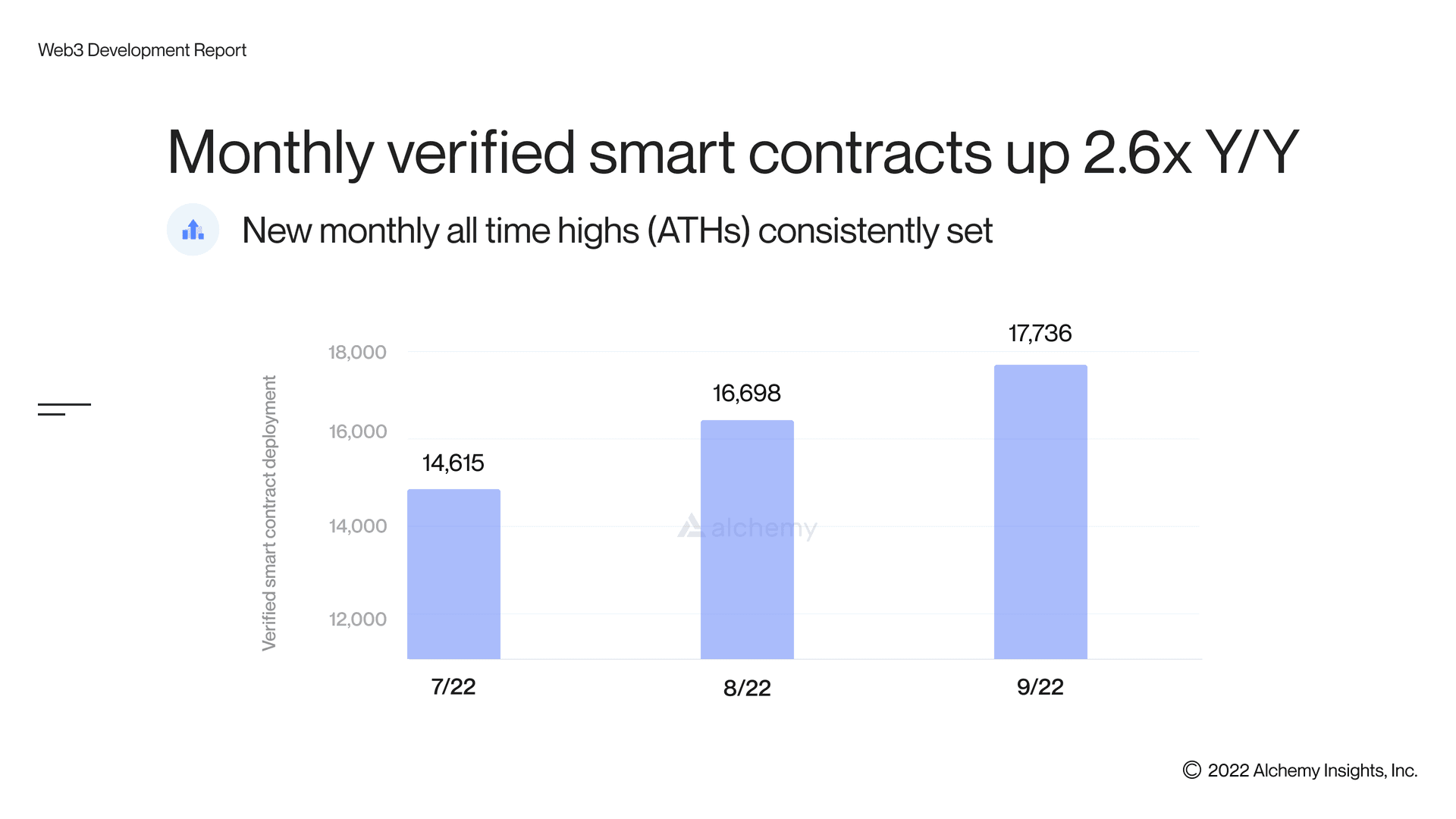
Lastly, another hallmark of ecosystem health is the number of dapps, or end-user applications with a decentralized backend, deployed in the ecosystem. DappRadar estimates that 12,495 dApps currently exist across all chains, up from around 1,000 in 2018. What’s more, approximately 2,500 of these dapps have at least 1 active user in the last 24 hours.
A few other highlights from the report include:
36% of all smart contracts ever deployed and verified have been in 2022
In the 2 weeks following The Merge, smart contract deployment increased by 14%
Despite Ethereum prices being down 62%, smart contract deployments have surged 40% to all-time highs
Over 16,000 waitlist sign ups in less than 1 week for Alchemy University, the new platform for learning how to build in web3
Since the start of 2022, Alchemy has seen the number of developer teams building on its platform increase 3x, but it’s important for us to step outside our own ecosystem to get a broader, more objective view of web3 developer health.
What we found, as you’ll see in the report, is that this vibrant community of web3 developers is still building useful, lasting products that change the way we connect with each other and the internet — all despite the wildest market conditions in a generation.
Methodology
This report strives to provide an accurate and useful representation of web3 development.The following sources were used for data collection purposes: Etherscan (verified smart contracts), DappRadar (dapp count), Github and NPM JS (SDK installations and metadata), CoinMarketCap (token prices), and the Internet Archive (fetching historical versions of aforementioned pages to provide timestamped data sources). web3 Javascript library weekly downloads were used as a proxy for developer activity here. This metric is helpful but imperfect due to the ability for the library to be downloaded multiple times by the same user intentionally or unintentionally. However, it provides one signal for directional guidance. Additionally, the growth of various blockchains on Alchemy is purely relative; certain chains are significantly larger as measured by active teams and daily requests.
Get all of the insights from the web3 development report.
How do you measure web3 developer activity?
There are three primary ways to measure web3 developer activity: (i) libraries, (ii) smart contracts, and (iii) dapps.
Libraries - developer tools to easily read and write data to the blockchain
Smart Contracts - Computer programs stored and executed on a blockchain
dapps - decentralized end-user-ready applications running on a blockchain
These three indicators reveal developers that are building, deploying, and growing.
How much is Ethereum down since Q3 2021?
Since the third quarter of 2021, Ethereum's native token, Ether (ETH), is down 56% Y/Y. The Decentralized Finance and NFT markets were also heavily impacted by the market crash. Since 2021, the total value locked (TVL) in DeFi applications has decreased 69% (Y/Y) and NFT marketplace trading volumes are down 88% Y/Y.
Total Value Locked (TVL) is a measure of how many digital assets are held in smart contracts used in Decentralized Finance such as borrow/lending protocols like Compound and Aave.
How many times have web3 developers downloaded Ethereum libraries?
In Q3 2022, web3 developers downloaded the Ethers.js and Web3.js libraries more than 1,536,548 times per week, a 178% increase Y/Y. Since 2018, developers installing either of these libraries on a weekly basis, has increased every year and in 2022, that number had increased 10X since 2018's high of 145,799 weekly downloads.
Total Combined Downloads
2018: 145,799
2019: 180,231 (+24%)
2020: 325,056 (+80%)
2021: 552,272 (+70%)
2022: 1,536,548 (+178%)
Industry analysts keep an eye on the Ethers.js and Web3.js libraries because these are core tools for building web3 products. These libraries let developers read blockchain data through providers like Alchemy and send transactions on behalf of their users to facilitate deposits into DeFi protocols, creating NFTs, and much more.
Ethers.js vs. Web3.js: Which Ethereum library is more popular in 2022?
In 2022, web3 developers downloaded the Ethers.js library 948,981 times, a 212% increase since 2021, compared to web3.js which was downloaded 587,567 times, a 137% increase since 2021.
Web3 developers have a choice of using either ethers.js or web3.js as their library for sending and receiving data from the blockchain. Because Ethers.js has more downloads and is growing at a faster rate than web3.js, it is the more popular Ethereum javascript library for developers in 2022.
Web3.js Downloads
Web3.js was the original library used by Ethereum developers, which is demonstrated by its higher number of total downloads between 2018 and 2020 compared to ethers.js.
2018: 91,936
2019: 113,272 (+23%)
2020: 161,257 (+42%)
2021: 247,999 (+54%)
2022: 587,567 (+137%)
Ethers.js Downloads
The rapid adoption of ethers.js between 2021 and today highlight's the market's growing preference of this library compared to web3.js.
2018: 53,863
2019: 66,959 (+24%)
2020: 163,799 (+145%)
2021: 304,273 (+86%)
2022: 948,981 (+212%)
How many smart contracts were published in Q3 2022?
48,689 verified smart contracts were published in the third quarter of 2022, a 143% increase Y/Y compared to 20,040 verified smart contracts that were published in Q3 2021.
Smart contracts represent the core logic for DeFi protocols and NFT minting contracts, similar to how server logic determines application and database behavior for many internet products today.
Over the last three months, Ethereum saw consecutive records for new All-Time-Highs of smart contract deployments:
July: 14,615 smart contracts
August: 16,698 smart contracts
September: 17,376 smart contracts
The all-time highs for smart contract deployment in each month of Q3’2022, peaking at 17,3775 in September, an increase of 2.6 times Y/Y, signals an acceleration in web3 development.
How many smart contracts have been published in 2022?
117,922 verified smart contracts were deployed to date in 2022 despite Ethereum's token price being down over 50% since 2021, and the year only being 75% complete, marking it the largest year to date.
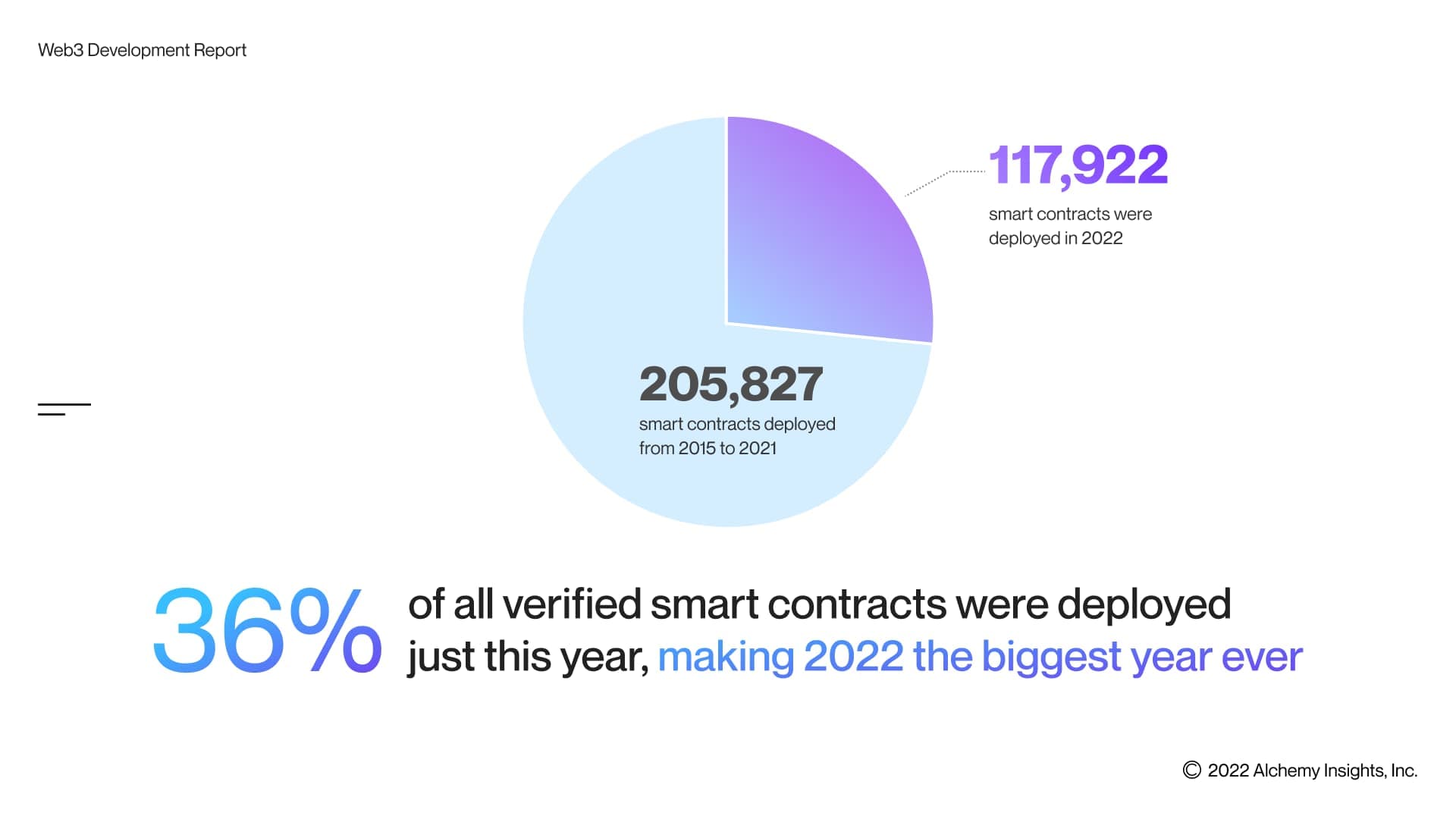
Here are the raw numbers:
323,749 smart contracts have been deployed ever
117,922 smart contracts were deployed in 2022 alone
36% of all verified smart contracts were deployed this year
How much have smart contracts grown since 2015?
Ethereum smart contracts have risen from 0 smart contracts in 2015 to a high of 44,023 smart contracts during the 2018 bull market, to All-Time-Highs in 2022 with 117,922 smart contracts, a 50% increase since 2021.

Here are the raw numbers:
2015: 0
2016: 808 (∞)
2017: 9,438 (+1068%)
2018: 44,023 (+366%)
2019: 24,281 (-45%)
2020: 48,471 (+100%)
2021: 78,806 (+63%)
2022: 117,922 (+50%)
Besides one down year during the 2019 bear market, Ethereum smart contract development has accelerated at an incredible rate.
Smart Contract Development is Not Tied to Crypto Prices
During the third quarter of 2022, Ethereum prices are still down 62%, and yet smart contract deployments have surged 40% to new All-Time-Highs (ATHs).

For example, when the price of Ethereum decreased 70% from $3,450 to $1,035 during Q2 2022 smart contract deployments only dropped by 4%. With prices decreasing 17.5 time larger than smart contract deployments, the prices and smart contract development aren't correlated.
How many dapps exist in 2022?
According to DappRadar, there are 12,495 dapps across all chains with at least 1 active user in the last 24 hours, which is up 1200% since 2018 when there were only 1,000 active dapps.

With the accelerated development of NFT APIs, enhanced APIs, and developer tooling, it is easier than ever to start building web3 dapps.
Q3 2022 NFT Development Statistics
According to data from Alchemy's NFT API, there has been a 10X increase in the total number of NFT API request this year to date, suggesting more use of NFTs in user facing products and analytics. While NFT marketplace activity is down almost 90% Y/Y, NFT developer activity remains high.
Q3 2022 Enhanced API Statistics
In Q3 2022, Alchemy's Enhanced API requests have 10Xed year-to-date confirming expansions in DeFi, DAOs, and gaming and from core node APIs to more advanced infrastructure. Alchemy's Enhanced APIs are a suite of APIs specifically built for developers who need tools for working with blockchain transfers, token metadata, token balances, transaction receipts, traces, debugging, and other web3 use cases.
Q3 2022 Archive Node Requests
This year to date, Alchemy archive node requests have increased two-fold, suggesting more developers are leveraging historical chain data for their dapps and web3 developer tooling. An archive node is a full Ethereum node that contains all blockchain data starting from the first genesis block.
Polygon Developer Statistics Q3 2022
Polygon is an Ethereum sidechain that is compatible with the Ethereum Virtual Machine. Polygon offers inexpensive gas fees and fast transaction times, making it a popular choice among web3 and web2 companies like Starbucks.
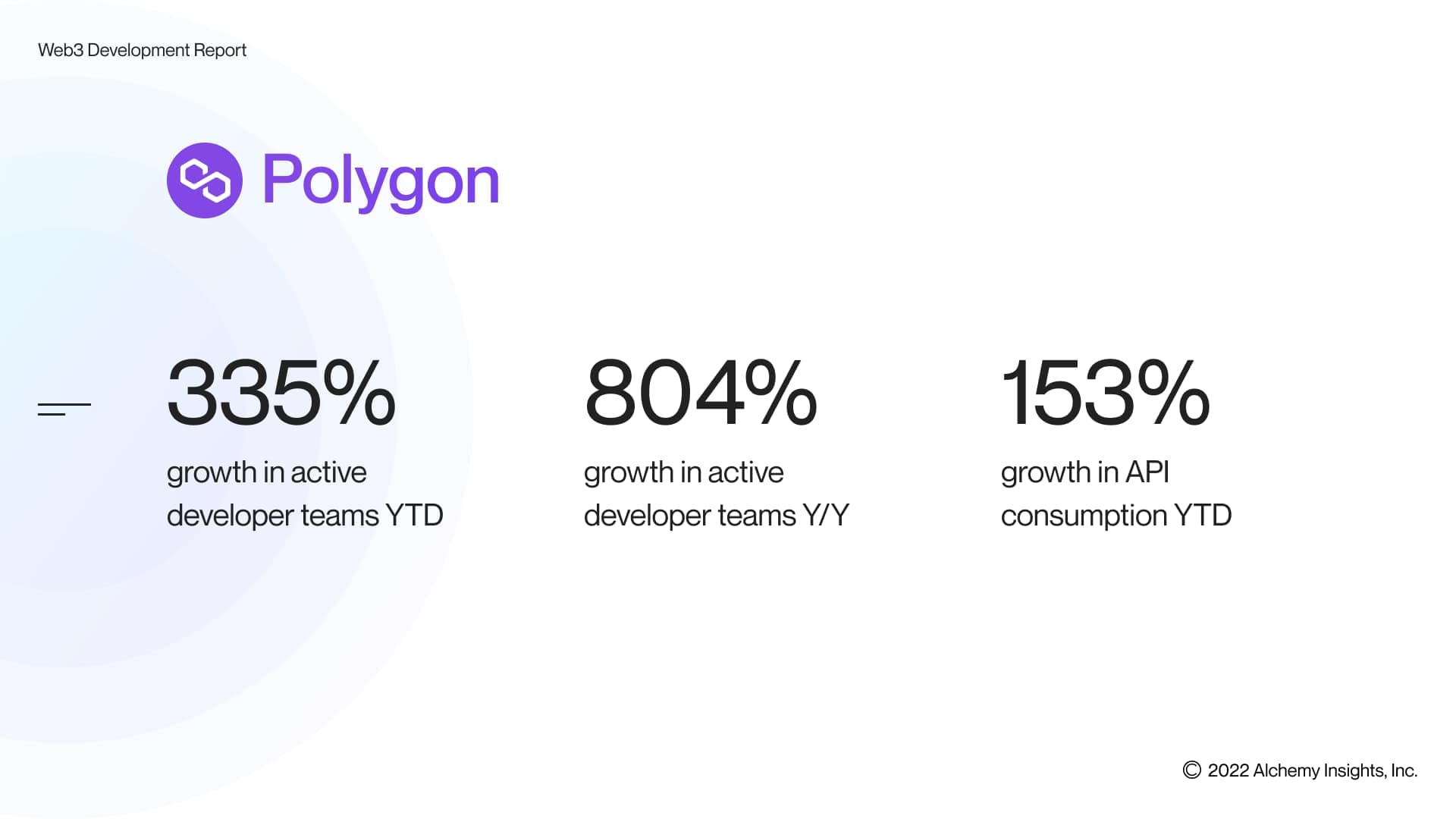
Here are the numbers:
335% growth in active developer teams YTD
804% growth in active developer teams Y/Y
153% growth in API consumption YTD
Optimism Developer Statistics Q3 2022
Optimism is a layer 2 (L2) scaling solution for Ethereum that uses optimistic rollups to enable up to 2000 transactions per second (TPS) with dramatically lower fees than deploying smart contracts directly on Ethereum.

Here are the numbers:
>1000% growth in active developer teams YTD
>1000% growth in active developer teams Y/Y
460% growth in API consumption YTD
Arbitrum Developer Statistics Q3 2022
Arbitrum is an Ethereum layer two scaling solution that uses optimistic rollups to increase Ethereum's scalability and decrease smart contract execution costs. In the third quarter of 2022 Arbitrum launched Arbitum Nitro, which increases the scalability of their blockchain for developers and users.
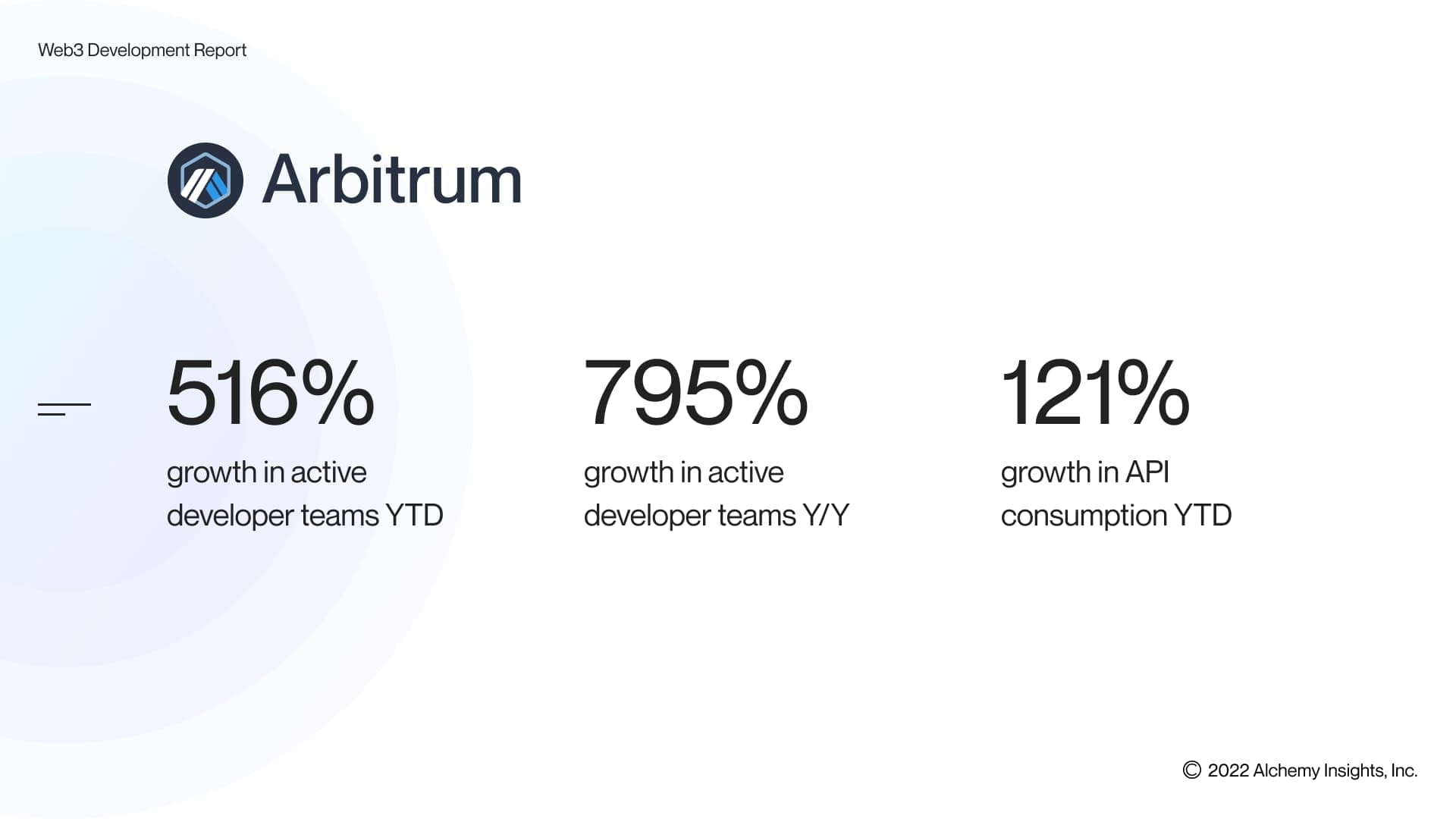
Here are the numbers:
516% growth in active developer teams YTD
795% growth in active developer teams Y/Y
121% growth in API consumption YTD
Solana Developer Statistics Q3 2022
Solana is a layer one smart contract development platform built using the Rust programming language. Alchemy started supporting Solana developers in Q3 2022. To date, Solana's active developer teams have grown over 1000% Y/Y and Year-to-Date with a 500% increase in API consumption YTD.
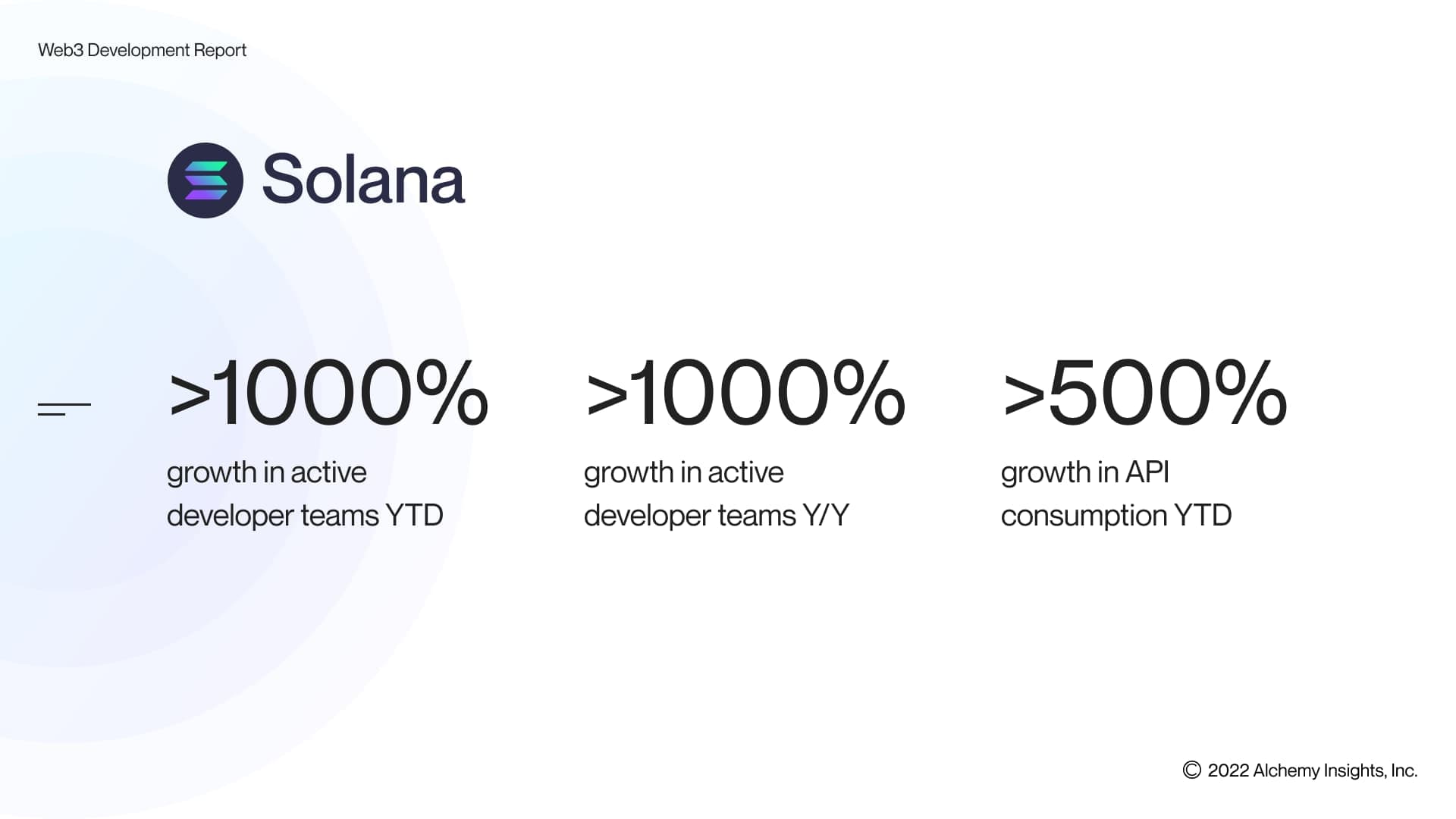
Here are the numbers:
>1000% growth in active developer teams YTD
>1000% growth in active developer teams Y/Y
>500% growth in API consumption YTD
Download the Q3 2022 Web3 Developer Report
Download the full report to access additional web3 metrics including:
Wallet and DeFi infrastructure growth
Social infrastructure growth
Data infrastructure growth
For inquires, please contact: [email protected]
Alchemy Newsletter
Be the first to know about releases
Sign up for our newsletter
Get the latest product updates and resources from Alchemy
By entering your email address, you agree to receive our marketing communications and product updates. You acknowledge that Alchemy processes the information we receive in accordance with our Privacy Notice. You can unsubscribe anytime.
Related articles
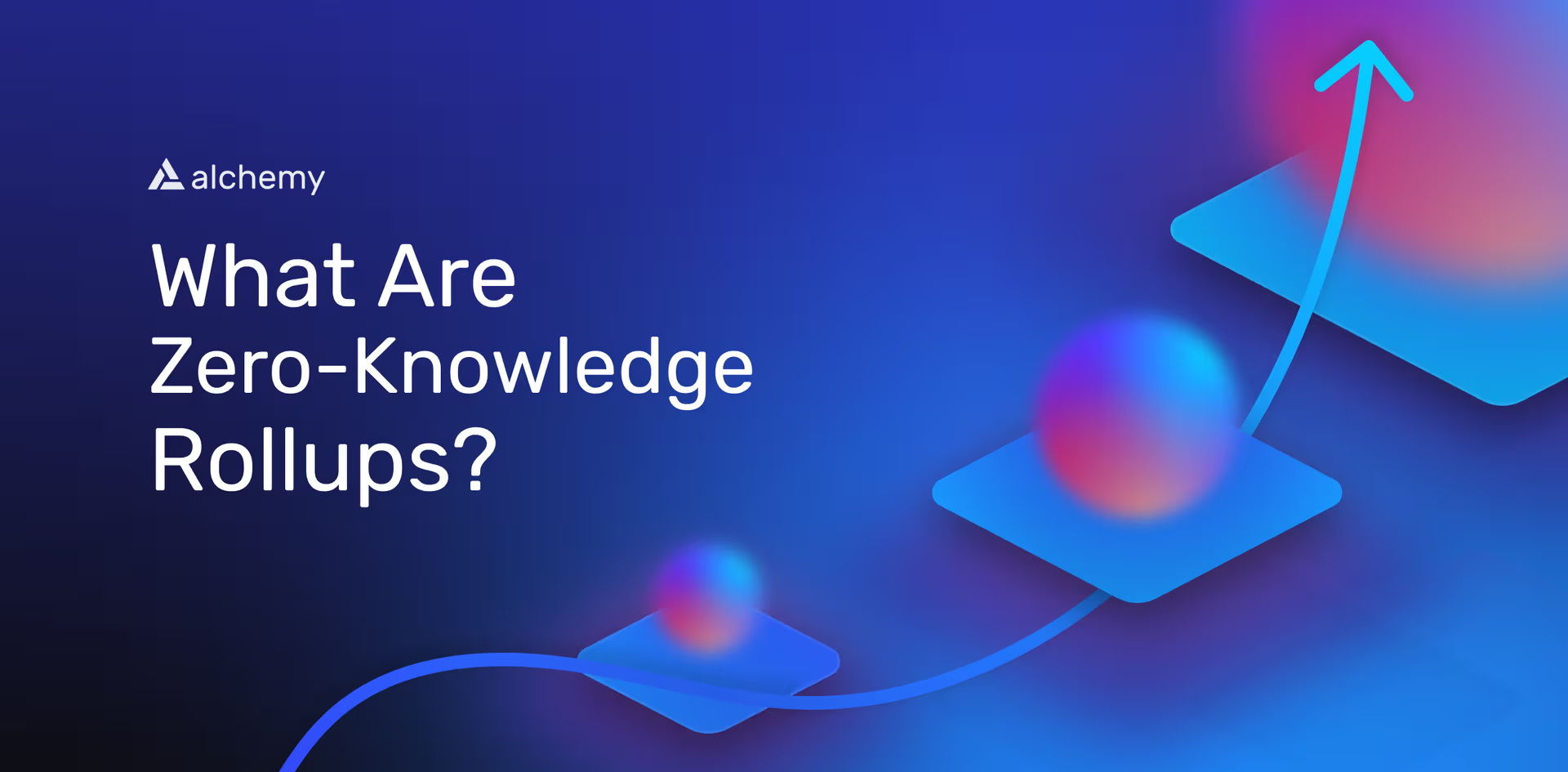
What are Zero-Knowledge Rollups (ZK-rollups)?
Explore ZK-rollups, a fast-growing L2 design. Learn how they cut costs, enable instant finality, and boost security.

Deploying Scalable Custom Rollups with a RaaS in 2025
Ambitious teams are increasingly deploying a rollup with RaaS in 2025. Here's why.
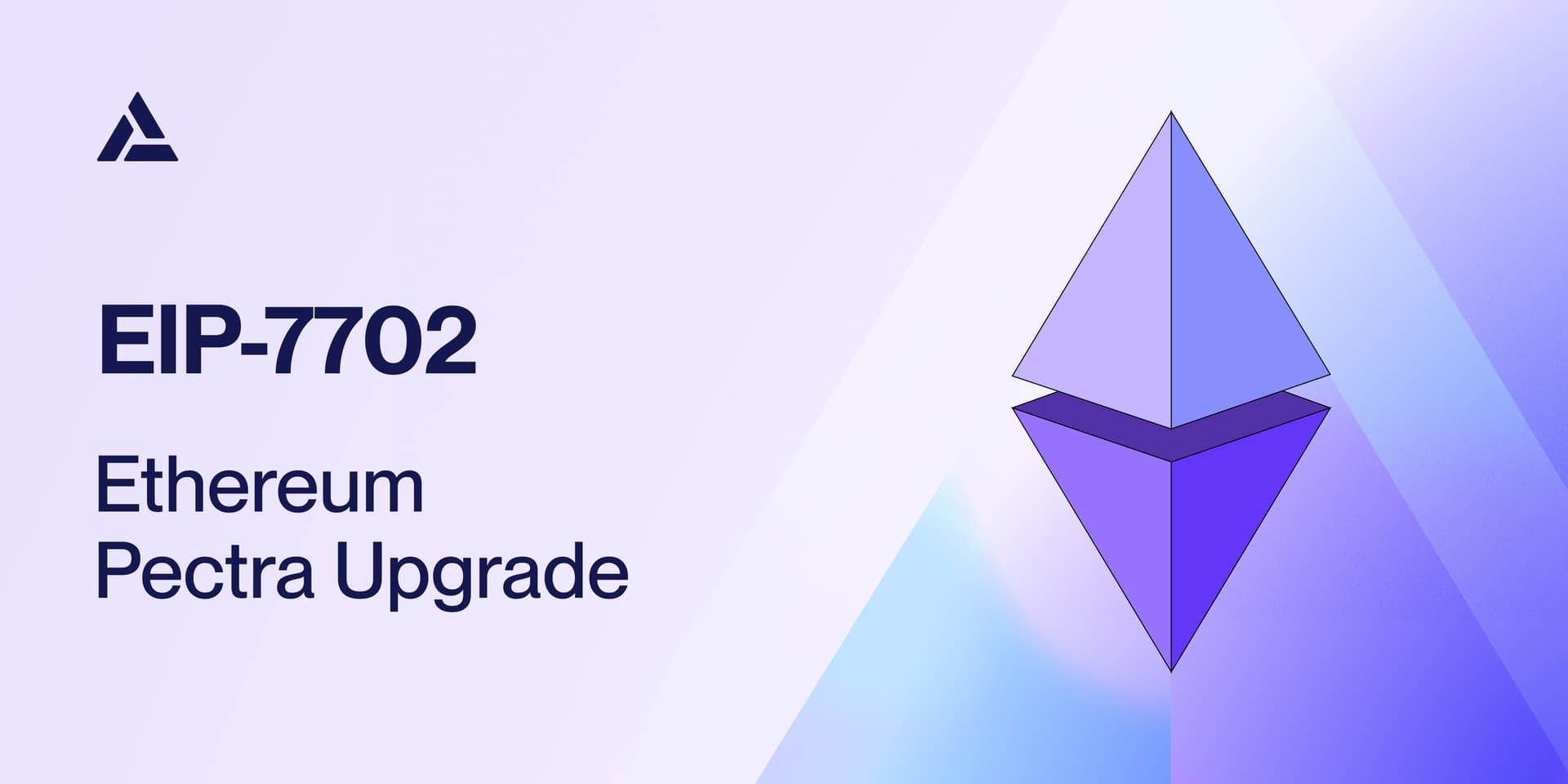
EIP-7702: Quick Integration Guide for Ethereum Developers Post-Pectra
Ethereum is on the brink of an important upgrade with EIP-7702. Here's a quick guide on integration considerations for all developers.